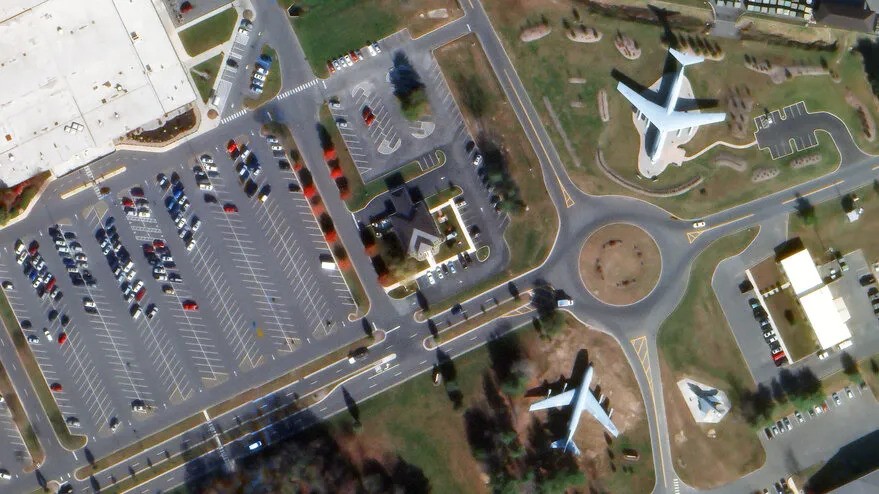Satellite startup Albedo aims to provide commercial orbital imagery so detailed that the military kept its own version under wraps — until it was leaked a few years ago by Donald Trump.
In 2019, then-president Trump tweeted a detailed image of a heavily damaged Iranian launch pad captured by a classified military satellite. The image, which was declassified in 2022, revealed what many in the commercial Earth observation industry suspected: that U.S. defense had the ability to capture images at a staggeringly sharp 10-centimeter resolution.
“When Trump tweeted a classified satellite image a few years ago that showed that we could capture 10-centimeter resolution from space, it sparked all this conversation in the commercial industry on how game-changing it would be to have that resolution commercially,” Albedo’s co-founder and CEO Topher Haddad said in a recent interview. “I stumbled upon that conversation a while after it happened and basically couldn’t get it out of my mind.”
At the time, Haddad was working on classified remote sensing satellites for the U.S. government at Lockheed Martin. A year later, Haddad teamed up with fellow Lockheed veteran AyJay Lasater and engineer Winston Tri to found Albedo, a company that’s aiming to do the impossible and deliver 10-centimeter resolution optical images to commercial customers at historically low costs.
(A 10-centimeter resolution essentially means that each pixel in an image covers an area the size of 10 centimeters by 10 centimeters on the ground. In comparison, the biggest optical imagery providers today collect images at a 30-centimeter resolution, which is algorithmically improved to 15 centimeters.)
Such low resolution, at a price the market will tolerate, is a big ask: The military satellites like the one that captured the image of the Iranian launch pad are widely believed to cost billions of dollars each. But Denver-based Albedo says it will be able to drive costs way, way down — not through big innovations on the optics side, but through its satellite bus platform that operates in very low Earth orbit (VLEO). That “is where the VLEO technology lives,” Haddad said.
Instead of joining all the other Earth observation players and operating in low Earth orbit (LEO), the orbital band around Earth at an altitude of around 2,000 kilometers, Albedo is targeting the lesser-known (but aptly-named) VLEO that’s between 250 and 450 kilometers. Albedo, which is almost entirely vertically integrated, has designed a satellite bus that is fully optimized for this environment: from the guidance, navigation and control (GNC) system; the robotics and software used to rapidly repoint the satellite and ensure images aren’t blurry; the solar arrays; and the mission planning and concept of operations to ensure that each satellite stays on orbit for an average of four years.
This last detail is key. While there are some upsides to operating in VLEO, like the fact that it’s less crowded and more protected from radiation, objects in that orbit are subject to a greater amount of atmospheric drag, since they are closer to Earth. But somewhat unintuitively, Albedo’s satellites avoid this issue by being very dense and heavy, and by using an efficient electric propulsion system to counter the drag.
The biggest technical challenges, Haddad said, are actually in the robotics, control and attitude systems:
“There’s three categories: there’s stability, which is making sure your picture isn’t blurry. There’s agility, so being able to rapidly repoint at different targets that you’re trying to image as you’re passing over very quickly . . . And then there’s accuracy, knowing exactly where you’re pointed, which is related to [stability and agility] and also gives you that geolocation metric that certain customers care a lot about,” Haddad explained.
“All those things at 10-centimeter resolution are just inherently very hard, because the angle from a single pixel is smaller than it would be for a 30-centimeter or 50-centimeter or three-meter. So any specific disturbance is going to impact the 10-centimeter pixel much more than a 30-centimeter pixel. Then you take that and you fly in VLEO, where the satellites are moving even faster around the Earth, there’s torque from the atmosphere, all those things just pose an even harder challenge for GNC.”
Investors have rallied behind the company’s vision. In September 2022, a little less than a year after completing Y Combinator, Albedo announced it had raised a $48 million Series A round. Now the company says it has closed $35 million in Series A-1 financing, at an up-round valuation.
The use cases abound, from commercial to defense. Reflecting the dual-use nature of VLEO tech, Albedo’s investors include funds like Bill Gates’ Breakthrough Energy Ventures to defense tech-focused Shield Capital. This latest tranche was led by Standard Investments, the investing arm of industrial giant Standard Industries. New investors Booz Allen Ventures, Cubit Capital, and Bill Perkins also participated in this round, along with existing investors (like Breakthrough and Shield), as well as Initialized Capital, Y Combinator, Giant Step Capital, Republic Capital, and others. With this latest capital, the company’s raised $97 million to date.
Right now, Albedo is working toward launch of its first commercial satellite in the first half of 2025. Haddad declined to specify a timeline beyond that date but said that the company’s next goal would be to launch a block of six satellites that would provide a daily global revisit rate, and ultimately a full 24-bird constellation that would offer five revisits per day.































Comment